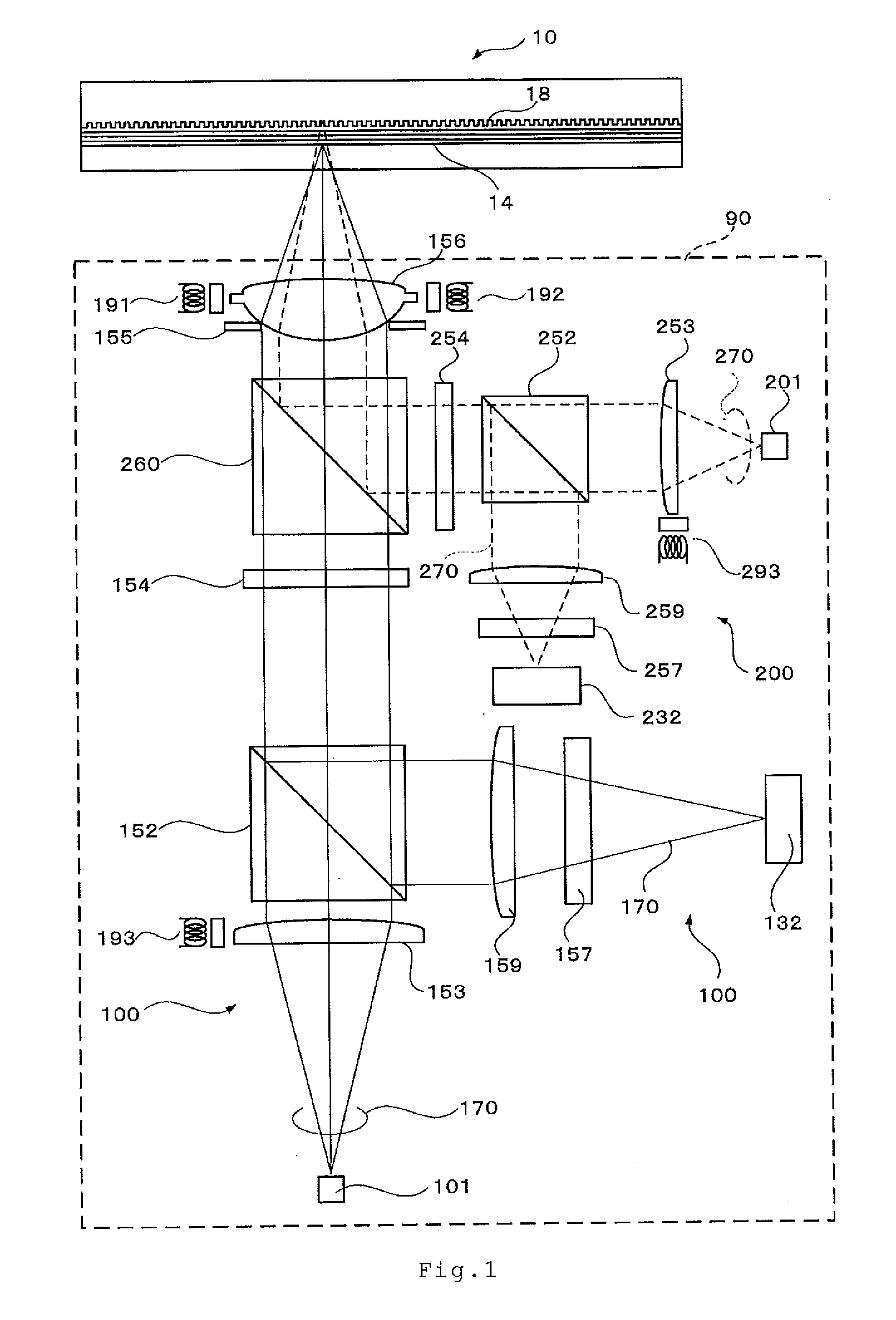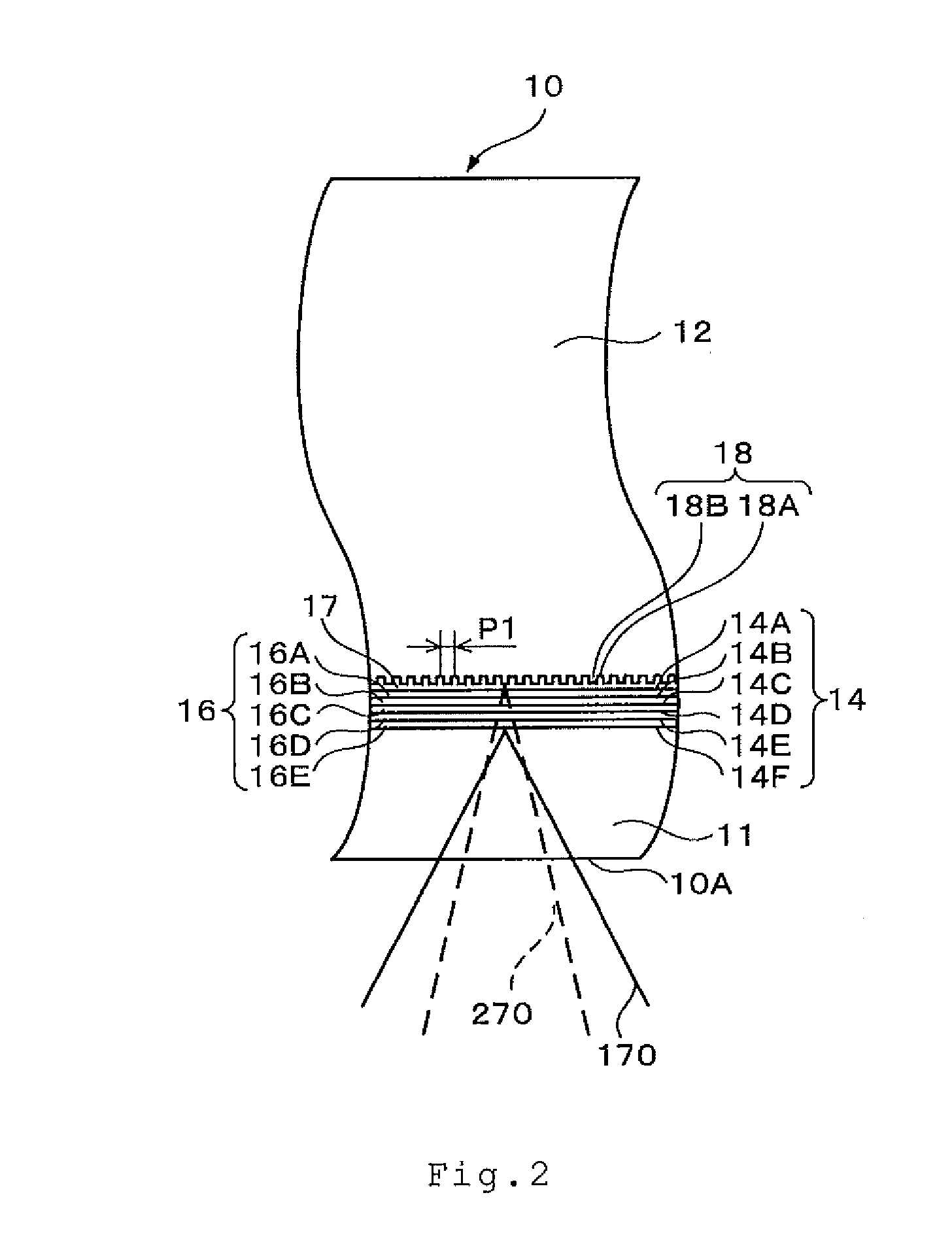Optical recording and reading method, optical recording and reading apparatus, optical recording medium, and method for producing an optical recording medium
a recording medium and optical recording technology, applied in the direction of manufacturing tools, instruments, disposition/mounting of heads, etc., can solve the problems of increasing production costs, complicated medium configuration, and difficult eccentricity adjustment work, so as to improve the signal quality of recording and reading, always stably performing tracking control, and improving the transfer rate
- Summary
- Abstract
- Description
- Claims
- Application Information
AI Technical Summary
Benefits of technology
Problems solved by technology
Method used
Image
Examples
first embodiment
[0122]FIG. 1 shows an optical recording medium 10 according to the present invention and a configuration of an optical pickup 90 used for recording and reading in this optical recording medium 10. The optical pickup 90 includes a first optical system 100 and a second optical system 200. The first optical system 100 denotes an optical system (i.e. recording and reading optical system) that performs recording / reading for a group of recording and reading layers 14 of the optical recording medium 10. The second optical system 200 denotes an optical system (i.e. tracking optical system) that performs tracking control using a servo layer 18 (described later) and a recorded area of the group of recording and reading layers 14 when recording information in the group of recording and reading layers 14 using the first optical system 100.
[0123]A divergent recording and reading beam 170 with a blue wavelength of 380 to 450 nm (405 nm in this case), which is emitted from a light source 101 of th...
second embodiment
[0189]A beam 270 which becomes a light source of a tracking optical system 20 in the optical pickup 90 has a red wavelength of 630 to 680 nm (650 nm, here). In the optical pickup 90 in the second embodiment, the wavelength is different between a first optical system 100 and a second optical system 200, and thus, beams 170 and 270 can be separated by a filter having wavelength dependence.
[0190]A servo layer 18 of the optical recording medium 10 is composed by forming a reflective layer on a concavo-convex pattern (lands and grooves) for tracking control of a support substrate 12. The recording and reading beam 170 is set such that an amount of reflected light when the recording and reading beam 170 is applied to a servo layer 18 becomes 5 times or less the amount of reflected light when the recording and reading beam 170 is applied to a group of recording and reading layers 14. As a result, when the recording and reading beam 170 is applied to the group of recording and reading layer...
fourth embodiment
[0247]As hereinbefore discussed, according to the optical recording medium 410 of the fourth embodiment, the servo layer 418 is formed on one surface of the support substrate 412, and the first group of recording and reading layers 414 and the second group of recording and reading layers 434 are disposed on both surfaces of the support substrate 412. As a result, because internal stress generated when the first and second groups of recording and reading layers 414 and 434 are formed is dispersed into both sides of the support substrate 412, warpage and deformation of the optical recording medium 410 can be prevented. Such dispersion of internal stress enables preventing warpage of the optical recording medium 410 even if a thickness of the support substrate 12 is set within the range of 10 to 1000 μm, and preferably, within the range of 10 to 600 μm.
[0248]At this time, an attempt to form concavo-convex patterns for tracking on both sides of the support substrate 412 complicates a pr...
PUM
| Property | Measurement | Unit |
|---|---|---|
| distance | aaaaa | aaaaa |
| reflectance | aaaaa | aaaaa |
| thickness | aaaaa | aaaaa |
Abstract
Description
Claims
Application Information
 Login to View More
Login to View More - R&D
- Intellectual Property
- Life Sciences
- Materials
- Tech Scout
- Unparalleled Data Quality
- Higher Quality Content
- 60% Fewer Hallucinations
Browse by: Latest US Patents, China's latest patents, Technical Efficacy Thesaurus, Application Domain, Technology Topic, Popular Technical Reports.
© 2025 PatSnap. All rights reserved.Legal|Privacy policy|Modern Slavery Act Transparency Statement|Sitemap|About US| Contact US: help@patsnap.com



